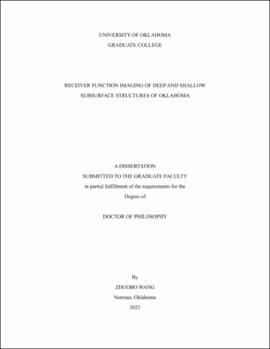| dc.description.abstract | The advancement of seismic imaging methodologies is driven by the requirement to attain a more comprehensive and accurate understanding of the subsurface, which holds significant importance for natural resource exploration, geohazard mitigation, and the interest of humanity about the geological history of the Earth and its prospective evolution. While active seismic imaging is dominantly applied in the exploration industry, passive seismic imaging methods which extract the subsurface information from natural sources (e.g., earthquakes, ambient noise, microseismism) offer nondestructive, economical access to the subsurface structures. Receiver function (RF) is an established passive seismic imaging method which traditionally reveals the deep-earth structure from teleseismic recordings. The abundance of earthquake sources around the world and established processing workflow makes the RF a promising method in investigating the upper mantle and crustal structure.
Oklahoma, situated geologically in the middle of the North American plate, has garnered significant attention from both the general public and the geoscience community due to the notable increase in intraplate seismicity over the past decade. However, our understanding of the deep structure of the Oklahoma crust and mantle remains limited, despite having approximate crust thickness estimates from seismic investigations on a continental scale. I address the crustal and mantle structure of the Oklahoma lithosphere by conducting teleseismic RF analysis in central Oklahoma, utilizing data from 169 broadband and short-period seismometers deployed by various monitoring networks. By converting the stacked RFs into the depth domain, this study provides the first detailed Moho map of central Oklahoma. The results indicate an eastward shallowing Moho, transitioning from over 50 km in the northwest to approximately 40 km in the east. Additionally, the RF depth cross-section reveals a mid-lithosphere discontinuity at a depth of 60-80 km within the upper mantle. Regarding the ongoing debate regarding the validation of midcontinent rift extension in Oklahoma over the gravity-anomalous zone, the RF analysis does not exhibit similar characteristics of crustal structure that are observed in the northern part of MCR, suggesting limited impact from the rifting processing within Oklahoma crust. However, the presence of intracrustal discontinuities observed in the RFs suggests the potential existence of rift-filling magmatism.
RFs derived from teleseismic events have limited capability in resolving shallow structures with high-resolution, primarily due to the absence of high-frequency components in teleseismic waveforms. Furthermore, deconvolution involving high-frequency component introduces instabilities to the inversion process and consequently less reliable RFs. To obtain high-resolution imaging of the shallow structures in the fault zone that ruptured the 2016 Mw 5.0 Cushing earthquake, I derived the RFs using local and regional earthquake data recorded by a nodal array comprising 130 portable seismic recording stations. A multichannel blind deconvolution approach is adopted to establish an inversion routine for retrieving high-resolution RF from local and regional earthquake data at a densely spaced array. The RFs clearly illustrate the primary conversion from the basement top interface, which cannot be observed from teleseismic RFs. The depth of this converted interface is approximately 1.15 km, which agrees well with an existing basement depth map.
Distributed Acoustic Sensing (DAS) from dark fiber introduces a new kind of data to the seismological community and holds great potential for earthquake detection applications. However, the earthquake wave responses of different DAS arrays may exhibit notable variations in signal to noise ratio and spectral sensitivity. These variations can be attributed to factors such as deployment conditions, surrounding noise levels, and fiber geometry. I present a comparative analysis of the waveforms of 2016 Mw 8.2 Alaska Peninsula earthquake from three DAS arrays (Enid, Ridgecrest, FORESEE-urban in State College). For comparison, waveform from nearby broadband stations is reviewed along with the converted particle velocity waveform from DAS strain and strain rate data. The three DAS arrays present the capability in capturing low-frequency signals while the variations of SNR exhibit between DAS arrays and internal sections, respectively. RF obtained from the combined Enid DAS array and conventional seismic receiver array show comparable conversion phases to those obtained from a broadband station. | en_US |

